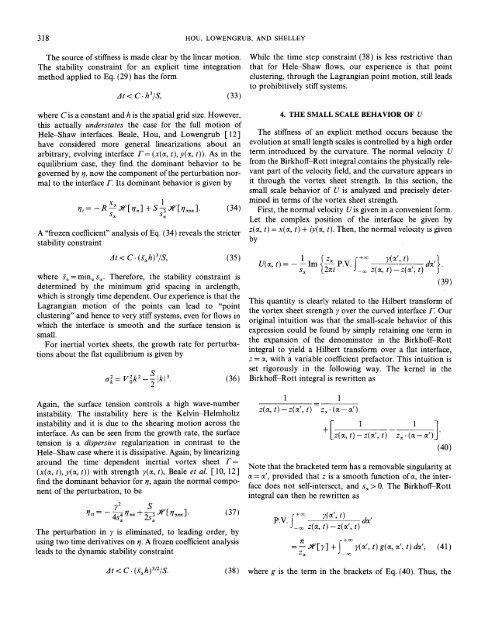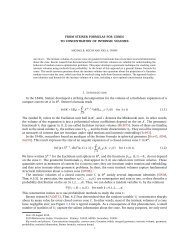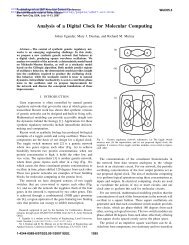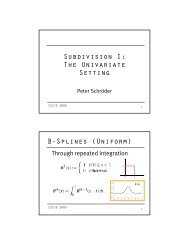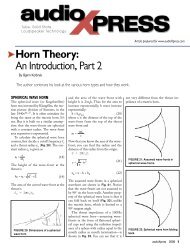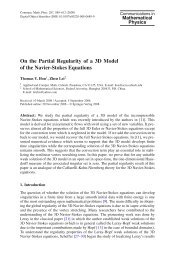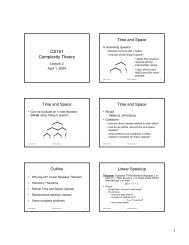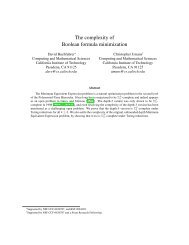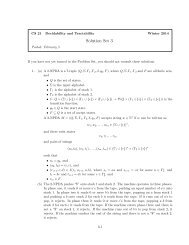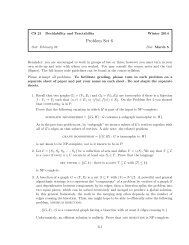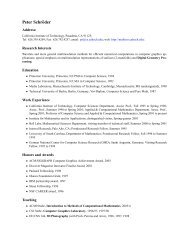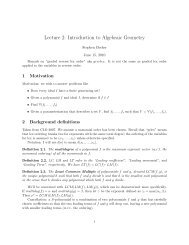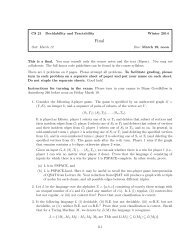Removing the Stiffness from Interfacial Flows with Surface Tension
Removing the Stiffness from Interfacial Flows with Surface Tension
Removing the Stiffness from Interfacial Flows with Surface Tension
Create successful ePaper yourself
Turn your PDF publications into a flip-book with our unique Google optimized e-Paper software.
318 HOU, LOWENGRUB, AND SHELLEYThe source of stiffness is made clear by <strong>the</strong> linear motion.The stability constraint for an explicit time integrationmethod applied to Eq. (29) has <strong>the</strong> form~It ff[rl~] + S1 )ffEq=~]. (34)S~ S aA "frozen coefficient" analysis of Eq. (34) reveals <strong>the</strong> stricterstability constraint~It < C. (g=h)3/S, (35)where g,=min, s,. Therefore, <strong>the</strong> stability constraint isdetermined by <strong>the</strong> minimum grid spacing in arclength,which is strongly time dependent. Our experience is that <strong>the</strong>Lagrangian motion of <strong>the</strong> points can lead to "pointclustering" and hence to very stiff systems, even for flows inwhich <strong>the</strong> interface is smooth and <strong>the</strong> surface tension issmall.For inertial vortex sheets, <strong>the</strong> growth rate for perturbationsabout <strong>the</strong> flat equilibrium is given byS~2 = V~k2_~ ikl 3. (36)Again, <strong>the</strong> surface tension controls a high wave-numberinstability. The instability here is <strong>the</strong> Kelvin-Helmholtzinstability and it is due to <strong>the</strong> shearing motion across <strong>the</strong>interface. As can be seen <strong>from</strong> <strong>the</strong> growth rate, <strong>the</strong> surfacetension is a dispersive regularization in contrast to <strong>the</strong>Hele-Shaw case where it is dissipative. Again, by linearizingaround <strong>the</strong> time dependent inertial vortex sheet F=(x(0~, t), y(~, t)) <strong>with</strong> strength 7(~, t), Beale et al. [ 10, 12]find <strong>the</strong> dominant behavior for r/, again <strong>the</strong> normal componentof <strong>the</strong> perturbation, to be),2 Stltt= --~S J~O[t/~ct~t]'a'=4 ?/~t"3I- ~-~-3 2s= (37)The perturbation in y is eliminated, to leading order, byusing two time derivatives on ~/. A frozen coefficient analysisleads to <strong>the</strong> dynamic stability constraintWhile <strong>the</strong> time step constraint (38) is less restrictive thanthat for Hele-Shaw flows, our experience is that pointclustering, through <strong>the</strong> Lagrangian point motion, still leadsto prohibitively stiff systems.4. THE SMALL SCALE BEHAVIOR OF UThe stiffness of an explicit method occurs because <strong>the</strong>evolution at small length scales is controlled by a high orderterm introduced by <strong>the</strong> curvature. The normal velocity U<strong>from</strong> <strong>the</strong> Birkhoff-Rott integral contains <strong>the</strong> physically relevantpart of <strong>the</strong> velocity field, and <strong>the</strong> curvature appears init through <strong>the</strong> vortex sheet strength. In this section, <strong>the</strong>small scale behavior of U is analyzed and precisely determinedin terms of <strong>the</strong> vortex sheet strength.First, <strong>the</strong> normal velocity U is given in a convenient form.Let <strong>the</strong> complex position of <strong>the</strong> interface be given byz(e, t) = x(e, t) + iy(~, t). Then, <strong>the</strong> normal velocity is givenbyU(o~,t)=_llm{Z ~ +oo y(o~',t) }P.v. f tl .(39)This quantity is clearly related to <strong>the</strong> Hilbert transform of<strong>the</strong> vortex sheet strength 7 over <strong>the</strong> curved interface F. Ouroriginal intuition was that <strong>the</strong> small-scale behavior of thisexpression could be found by simply retaining one term in<strong>the</strong> expansion of <strong>the</strong> denominator in <strong>the</strong> Birkhoff-Rottintegral to yield a Hilbert transform over a flat interface,z = ~t, <strong>with</strong> a variable coefficient prefactor. This intuition isset rigorously in <strong>the</strong> following way. The kernel in <strong>the</strong>Birkhoff-Rott integral is rewritten as1 1mz(o~,t)-z(og, t) z,.(o~-o~')[ 1+ z(oq t)- z(og, t)(40)Note that <strong>the</strong> bracketed term has a removable singularity at= e', provided that z is a smooth function ofcq <strong>the</strong> interfacedoes not self-intersect, and s~ > 0. The Birkhoff-Rottintegral can <strong>the</strong>n be rewritten asf+~ 7(0~', t)P.V. -~ z(cq t) -z(~', t) d0(n ~ff[7]=_ +f+~Z~ oo7(~',t)g(ot, o~',t) d o~',(41)At < C. (gah)3/2/S. (38) where g is <strong>the</strong> term in <strong>the</strong> brackets of Eq. (40). Thus, <strong>the</strong>


